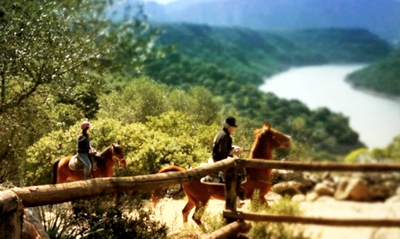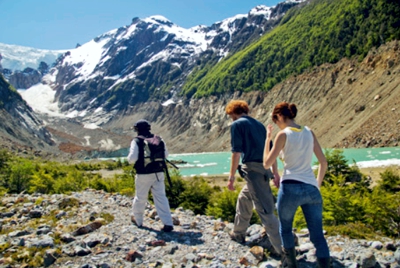

Destinations
Experiences
 |
L A
D A T C O T O U R
S |
 |
||||||||
| HOME | South America | Falkland Islands | Antarctica | Unique Destinations |
Unique Experiences |
Newsstand | ||||
 |
El Aura Los Alerces National Park Lodge
Information |
 |
ABOUT ACTIVITIES AVAILABLE AT EL AURA LAGO VERDE LODGE - in their own words:
In this unique and wild land there is no limit for your imagination.
Fly fishing, trekking, camping, swimming, boating, kayaking, biking, picnicking, equestrian adventures, bird watching and gatherings around a fire with friendly people at night are the favorite activities.Evening is an special time. As the sun falls behind the mountains, the light becomes blue and fades slowly into darkness. This is the time to either walk along the shore, sit in the deck
to listen to the last birds sing or just share the day’s experience with your companions
Moon nights can be just spectacular. The air is so pure and clean that you can walk along the trecks with no other light than the moon. And while the world we know goes to sleep a new one awakes, with its own shapes, colors and sounds. Walks under a bright moon is something you cannot miss.The National Park is waiting for you, the forest, lakes and rivers can offer you as many opportunities as you imagine or desire. We can drop you in an island for lunch or guide you through the forest, or …just let us know what you wish and we will make it real.
Los Alerces National Park - From Wikipedia, the free encyclopedia
The Los Alerces National Park is a national park in Chubut Province, Argentina, some 30 miles from Esquel. It is a park of 2,630 square kilometres along the border with Chile, best known for the alerce (lahuan) trees (Fitzroya cupressoides) from which the park takes its name.
The park was created in 1937 in order to protect the alerce forest, and other typical examples of the flora of thePatagonia Andes. The National Park has the largest alerce forest of Argentina. Alerce is one of the longest-living trees in the world; some in the park are around 3,000 years old, with many of them over 1,000 years. It grows very slowly and belongs to the family Cupressaceae. The principal forest in the park, visited by tourists, is at Puerto Sagrario at the northern end of Lago Menéndez. Arrayan (Luma apiculata) trees can be seen along the Arrayanes river.
In the west of the park, there is high rainfall and Valdivian temerate rain forests below the high Andes mountains. Much of the rest of the park is Patagonian forest similar to the Lanin and Nahuel Huapi National Parks, with coihues and lenga in addition to the alerce. There is a complex lake system with many rivers. The most important are the Menendez, Rivadavia, Futalaufquen and Krüger lakes, and the Frey river. A hydroelectric dam, providing energy to industry in Puerto Madryn, has created the large artificial Lake Amutui Quimei, which empties into the Futaleufu River which flows on to Chile. The Torrecillas glacier can be seen from tour boats.
There is good walking and fishing in the park, plus boat trips on the lakes.
Besides the National Park there are some other interesting visits, such as:
LELEQUE MUSEUM:
Leleque Museum it is but the showcase for a scientific-cultural project of original projections and antecedents. Initiated by the romantic motivation of a sort of Patagonian pioneer stuck in time, originally-Russian Pablo Korschenewski got his citizenship in Leleque. The very name of this spot keeps native echoes, referring to a regional shrub in the language of the Patagonian Meridian Tehuelche. It is also a richly symbolic place ever since it became the scenario for the last skirmish in the battle of national troops against the remaining groups of Tehuelche aborigines having offensive weapons (spears), in 1888.This project intends to rescue and exhibit the essential aspects of Patagonian history, from the standpoint of the aborigines, the millenary peoples of this territory. Moreover, this is the result of regional scientific investigation, together with the preparation of human resources, through publications, videos and fairs. We are pleased to invite you to enjoy our current show, “Patagonia: its history”, and to rest for a while in a cozy and refreshed Patagonian "boliche".
EL BOLSON:
The village of El Bolsón is nestled at the foot of Mount Piltriquitrón, on the banks of the Quemquemtreu River. Its history dates back to 1880 with the small agricultural settlements. But it was not until 1926 that it was organized as a municipality. In turn, the heterogeneity of its population is due to a significant migratory current both from Argentina and from some European countries. A particular microclimate prints a different scenery on each season. In the winter, the snowed slopes of Mount Perito Moreno enable visitors to practice ski. The spring and the fall explode in reddish, ocher and green shades in the cypresses, coihues and lengas growing in its forests. In the summer, the water courses are ideal for fishing, lake rides and other nautical sports such as surfing and river rafting. Visitors may also enjoy hikes, horseback rides, mountain biking and climbing, or spending a day on the beach by some lake or creek. The community develops an intensive agricultural activity that may be observed during a visit to its farms, specialized in growing mainly hop (used to aromatize beer) and fine fruit. In addition to being the venue for the National Hop Festival, El Bolsón is best-known for its regional handicrafts' market, where pottery, wool, leather and metal works, dry flowers, jams, fresh vegetables, knives and candles are for sale.TREVELIN:
Trevelin means "mill town" in Welsh. This statement perfectly serves as an introduction to this lovely place: a small town populated by Welsh and its descendants in Patagonia, built around the first flour mill in the region. Trevelin was founded during the Welsh immigration period in the province of Chubut, around 1860. This place's most important and unique characteristic is the colonial fusion that took place over the years between these Welsh immigrants and the natives of the area, the Mapuche Indians.Besides fly fishing, other activities include:
HORSE RIDING: (Season:
November thru April)
|
Our Guides: Analía Bosch: shes a keen rider that shares her time between chinese medicine, massage and organizing outdoor programs. Her home is in Esquel, and her passion for our landscape is contagious. Diego Brand: has lived in the area most of his life, guiding for different outdoor activities: mountain, fly fishing, riding. Diego has travelled and worked in many countries, but this part of Patagonia is his home. |
Half Day Rides:
This is a short ride, approx. 3 hours. Departing from the lodge at Lago Verde we drive
through the National Park and arriving to Esquel town in an hour and a half journey. We
meet our hosts at a small farm, La Petrona, where dayly ranch life and works with cattle
is taking place. Once on the horses, we will ride by the foothill of the Nahuel Pan, with
great views of the different valleys, mountains and paths, of this great open land. End of
the ride, short drive into Esquel where different activities can be organized. There are also 6 hours rides and two day rides with overnight in tents. |
BIRDWATCHING: (Season:
October to April)
|
The guides: Lorena MartÌnez Peck (Biologist) and Gabriel Popesciel (Engineer) manage a Consultant Bureau focused on the planning and sustainable development for projects in the Patagonian region, settled in Esquel since 1994, with wide and well known experience in environmental management and services, under the name Rehuna S.A. since 2004. In Rehuna works an interdisciplinary team formed by outstanding professionals, who are able to handle a wide-ranging spectrum of enviromental problems and projects. Such team lives in the Patagonian region thus assuring an intimate knowledge of the region and a frank commitment with its sustainable development. Regarding birdwatching Lorena MartÌnez Peck has worked training human resources as guides for birdwatching and has led many projects. She was also honored with an award given by NGO Bird Life International. |
|